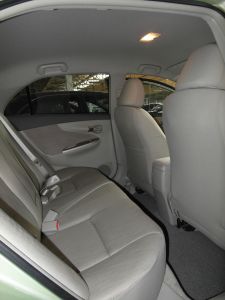Cars with manual gearbox among daily commuters has become a very rarity, and one of my colleagues, an avid fan of the manual gearbox had decided to upgrade his N16 (manual gearbox) with an Toyota Axio manual gearbox. The car he got was a pristine example with an auction grade 5, interior A and just 9,000km on the clock.
He was kind enough to provide me test drive, and also share some of the user experience in comparison to the N16 he had.
Did the criminal sin that i had not charged my camera’s battery, so my photo shoot for the article sadly was only half complete.
Engine
The car has the same engine as the Allion A15G, the 1496cc 1NZ-FE base engine in the A15 provides 110PS/6000 power, and 140Nm/4400 of torque.

The engine is a quiet one, and lacking any aural thrill the Honda fans would crave for. The pickup of the vehicle at low speeds as in the Allion is remarkable, and coupled this time with a manual gearbox, provides extreme rapid take-offs. However once you go beyond the 1st gear, the surge is more sedate and tapers off in the mid range before it gets a bit more lively at the higher speeds.
The tractability of the engine though is remarkable, as you can cruise around even in the second gear, indicating that long gearing might be in place to promote fuel efficiencies.
Transmission
Driving a manual gearbox after a while, and it was a pleasant experience. The manual gearbox is quite smooth, though no match for the Honda Fit manual i drove some time back. A touch notch but still very light and confidence inspiring and the shorter gear knob gives a quick shift feel.
Exterior
The Axio design definitely is Toyota playing its safe style, and is very conservative lacking any real visual drama. The design is clean, but lacking inspiration. The model i drove had the standard light cluster, though some of the models i saw on the road had the more cooler looking project type cluster.


Interior
This car being a G grade model, has the higher quality seating materials. However the quality is not in the same league as the Allion. My friend also commented that the seats were a lot firm, and not as comfortable as his older N16. The seats are narrow, and while suitable for the thinner folks, a bit lacking in width for the bulkier person such as myself! The singular knob for height adjustment seems a bit lacking.


A thing that brought me joy was the handbrake being a true handbrake and not a foot brake as was the case with a lot of new auto gearbox cars. I am sure only a person who drives in Sri Lanka will truly appreciate the ease the hand brake brings compared to the foot brake due to the high frequency we have to use it in general city driving.
The rear seat space seems lacking and disappointing. My humble opinion is that the newer hatchbacks a class lower such as the Honda Fit having oodles of space for the rear occupants. Another work mate who upgraded from an Fit Aria, also indicated that his wife had commented the Axio was less spacious in the rear specially in the legroom. However the boot is well sized.

The dashboard console is simple and functional with orange lighting. Unlike the CVT variant i drove of my other work mate, the manual car has a normal LCD meter and separate analog meters for fuel, etc. The LCD indicators are also in English as opposed to Japanese in the automatic gearbox versions.

Ride and Handling
The Axio though lighter than the Allion, and the Axio handles the local rutty roads extremely well, giving a comfortable ride even in the most bumpy parts. However for an enthusiast they may find the ride a tad on the softer side, but the advantage is that the vehicle does not loose composure on the rippled, rutty roads and maintains high degree of comfort for its occupants. The standard tires are the 185/65/R14, and with the thick sidewall, these tires also help maintain the ride comfort. However one observation from the owner was that the lighter weight of the car was noticeable at higher velocities.
In town driving the car is fairly nimble and has a decent turning circle, and also manages to control the torque with no wheel spin. Yeah wheel spins are cool, but sadly they don’t help improve performance straight of the line as thats a sign that car is not able to get traction.
The car i drove also feature 195/60/R15 tires, larger than the standard 185/65/R14 which do service in most Axio’s. The large tread size seemingly helping in improving the road manners of the car, though this should have an impact on the overall fuel economy of the car.
Fuel Economy
Shall update this after i get an update from the owner after he has got a few more miles in local conditions. However it seems the manual gearbox has a 0.5-1kmpl advantage over the CVT gearbox in peak hour city driving mode, so the CVT definitely bridging the gap in fuel economies compared to a standard auto box.
| City / Urban – Peak Hours |
|
9-10kmpl |
| City / Urban – Non Peak Hours |
|
10-11kmpl |
| Outstation / Highway – Narrow roads |
|
|
| Outstation / Highway –Wide roads |
|
14-16kmpl |






